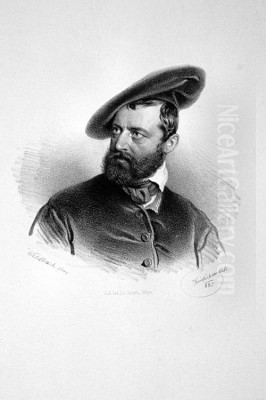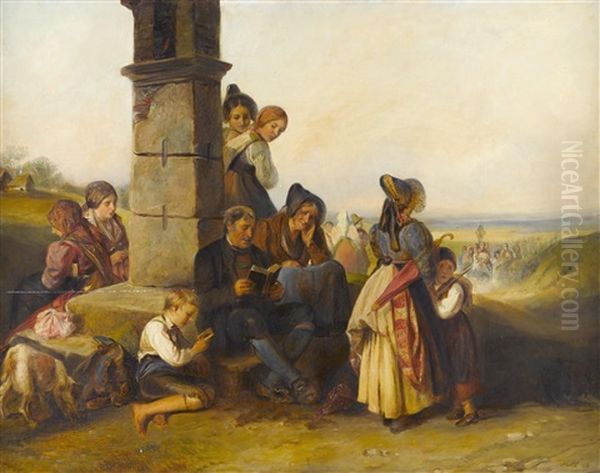
Johann Matthias Ranftl stands as a significant figure in 19th-century Austrian art, particularly associated with the Biedermeier period and Viennese Romanticism. Born in Vienna in 1804 and passing away in 1854, Ranftl carved a unique niche for himself, earning the affectionate, albeit slightly informal, title "Raffael der Dogge" or "Raphael of the Dog" due to his exceptional skill in portraying canines with remarkable realism and sensitivity. His artistic journey encompassed rigorous academic training, influential travels, and a diverse output that included genre scenes, portraits, landscapes, and religious subjects, leaving a lasting mark on the Viennese art scene.
Early Life and Academic Foundations
Johann Matthias Ranftl's artistic path began in his birthplace, the imperial city of Vienna. In 1817, at the young age of thirteen, he enrolled at the prestigious Academy of Fine Arts Vienna (Akademie der bildenden Künste Wien). During these formative years, he studied under notable figures such as Johann Baptist Lampi the Elder, a renowned portraitist, and Anton Petter, a history painter associated with Neoclassicism who later became the Academy's director. This initial training provided Ranftl with a solid grounding in drawing, composition, and the academic traditions prevalent at the time.
His education was not confined to Vienna. In 1819, Ranftl embarked on a study trip, venturing first into Switzerland and subsequently into Germany. These travels exposed him to different landscapes and artistic currents, broadening his horizons beyond the Viennese milieu. Such journeys were common for aspiring artists, offering invaluable opportunities for direct observation and sketching from nature, experiences that would later inform his landscape and genre works.
The Influence of Johann Peter Krafft
Upon returning to Vienna, Ranftl continued his studies, significantly benefiting from the tutelage of Johann Peter Krafft. Krafft, a prominent painter known for his historical scenes and realistic portraits, exerted a considerable influence on Ranftl's development. Krafft championed a form of realism grounded in careful observation and precise execution, moving away from the stricter Neoclassical ideals of some of his predecessors.

Under Krafft's guidance, Ranftl honed his skills, particularly in figure drawing, which he initially mastered through the discipline of history painting. This training proved invaluable, even as his interests began to shift. While initially focusing on historical subjects, as evidenced by the two historical paintings he submitted for his first Academy exhibition in 1826, Ranftl gradually developed a strong affinity for landscape painting and portraiture, likely encouraged by Krafft's own versatility and emphasis on realistic depiction.
Travels and Broadening Horizons: Russia and London
Ranftl's ambition and talent led him beyond the borders of the Austrian Empire. He spent time working in Russia, exhibiting his works in both St. Petersburg and Moscow. During this period, he received commissions, including painting portraits for the Russian court, demonstrating his growing reputation. This exposure to the Russian art scene and patronage system further enriched his experience.
After returning to Vienna around 1830, Ranftl initially focused on more traditional commissions, including religious altarpieces and portraits of royalty. However, a pivotal journey occurred in 1838 when he traveled to London. This trip was reportedly undertaken at the invitation of Prince Paul Anton Esterhazy III, a member of the influential Hungarian noble family known for their patronage of the arts, particularly associated with the composer Joseph Haydn decades earlier.
In London, Ranftl immersed himself in the study of British art. He was particularly captivated by the work of Sir Edwin Landseer, the preeminent animal painter of Victorian England. Landseer's dramatic and often anthropomorphic depictions of animals, especially dogs and stags, resonated deeply with Ranftl. A strong friendship developed between the two artists, fueled by their shared passion for depicting dogs. This encounter proved transformative for Ranftl, solidifying his commitment to animal painting and significantly shaping his approach to the subject. He absorbed Landseer's techniques for capturing animal anatomy, fur textures, and expressive qualities, though Ranftl often maintained a more grounded, less sentimental Biedermeier realism compared to Landseer's sometimes overtly dramatic or narrative style.
The Biedermeier Context and Genre Painting
Upon his return from London and settling back into Viennese life, Ranftl fully embraced the artistic spirit of the Biedermeier era (roughly 1815-1848). This period, characterized by a focus on domesticity, middle-class life, intimacy, and a certain sentimental realism, provided fertile ground for Ranftl's talents. While political and social life was constrained under the conservative regime of Metternich, art turned towards the private sphere, celebrating simple pleasures, family life, and the beauty of the everyday.
Ranftl became a key exponent of Viennese Biedermeier genre painting. He moved away from grand historical or mythological themes to depict scenes of ordinary life, often imbued with a quiet charm and meticulous detail. He was closely associated with other leading figures of this movement, notably Josef Danhauser, whose interior scenes and moralizing narratives were highly popular. Ranftl can be seen as a follower of Danhauser in some respects, sharing a commitment to detailed realism influenced by their common teacher, Johann Peter Krafft. Other contemporaries who defined the Biedermeier style in Vienna included the portraitist Friedrich von Amerling and the versatile Peter Fendi, known for his intimate genre scenes and watercolours. Franz Eybl, another prominent Biedermeier painter often grouped with Danhauser and Ranftl, also focused on portraiture and genre subjects. Ranftl's work fit comfortably within this milieu, contributing significantly to its character.
Master of Animal Painting: The 'Raphael of the Dog'
While accomplished in various genres, it was Ranftl's extraordinary ability to paint dogs that truly set him apart and earned him his famous nickname. The title "Raffael der Dogge" (or variations like "Raffael des Hunds") compared his mastery in depicting dogs to the High Renaissance perfection associated with Raphael Sanzio in figure painting. This was high praise, reflecting the exceptional lifelikeness, anatomical accuracy, and sympathetic portrayal he achieved in his canine subjects.
His dog paintings were not mere anatomical studies; they captured the animals' individual character and presence. Whether depicting loyal companions, working dogs, or simply animals observed in their environment, Ranftl imbued them with a vitality that resonated with audiences. His time with Edwin Landseer undoubtedly refined his technique, but Ranftl's dogs often possess a distinctly Austrian Biedermeier sensibility – less overtly narrative or allegorical than Landseer's, perhaps, but deeply observed and rendered with palpable affection. Works like Hundekopf (Dog's Head), likely a detailed study or portrait of a specific dog, exemplify this focus. His skill extended to other animals as well, as seen in works potentially titled Animals in a Trap, showcasing his broader interest in the natural world.
Diversity of Subjects and Notable Works
Despite his fame as a dog painter, Ranftl's oeuvre demonstrates considerable range. He continued to produce portraits throughout his career, capturing the likenesses of his sitters with sensitivity. Der Grossvater (The Grandfather) suggests a focus on intimate family portraiture, a hallmark of the Biedermeier period. His A Flower Girl, dated 1836, showcases his ability to render charming genre figures.
Religious themes also remained part of his output. Works like Die Segenswünsche des heiligen Nikolaus (The Blessings of Saint Nicholas), depicting children at a window, likely combined religious sentiment with Biedermeier domesticity. He is also known to have painted altarpieces during his earlier post-Russia period and potentially works like a Madonna and Child.
Genre scenes depicting rural life and everyday activities were central to his Biedermeier identity. Der Junge Heimatsammler (The Young Gatherer or perhaps The Young Shrub Collector) portrays a youth engaged in outdoor work, reflecting an interest in simple, often rural, labour. Auf dem Kirchgang (Going to Church or On the Way to Church) depicts a mother and child crossing a stream, a scene rich in narrative potential and evocative of community life and piety. The Corpus Christi Procession would have been a larger, more complex genre scene capturing a significant religious and social event.
His versatility is further highlighted by his contribution of illustrations to the satirical play Die Republik der Tiere (The Republic of Animals) by the Austrian writer Eduard von Bauernfeld in 1848, the year of revolutions across Europe. This project allowed him to combine his skill in animal depiction with social commentary.
Later Career, Style, and Legacy
In 1849, Johann Matthias Ranftl became a member of the Vienna Academy of Fine Arts, the institution where his artistic journey had begun decades earlier. This appointment acknowledged his standing within the Viennese art world. He remained associated with the Academy until his death.
Ranftl passed away in 1854 in Weidlingau, near Vienna, at the age of 50. His artistic style can be summarized as a blend of Biedermeier realism, characterized by meticulous detail, smooth finish, and often warm lighting, with elements of Romantic sensibility, particularly in his sympathetic portrayal of animals and his evocative landscapes. His grounding in Krafft's realism provided the technical foundation, while his exposure to British art, especially Landseer, refined his approach to animal painting. He masterfully balanced precise observation with a gentle, often sentimental, mood appropriate to the Biedermeier ethos.
His influence extended through his association with the Academy and his position as a leading figure in the popular Biedermeier movement. Along with Danhauser, Amerling, Fendi, Eybl, and the slightly older but highly influential Ferdinand Georg Waldmüller (known for his luminous realism in portraits, landscapes, and genre scenes), Ranftl helped define the visual culture of Vienna in the first half of the 19th century. His specialization in animal painting, particularly dogs, gave him a unique and enduring reputation.
Historical Context and Provenance Issues
Like many artworks from European collections, some of Ranftl's paintings have complex histories intertwined with the turbulent events of the 20th century. Notably, two of his works, Nachernte (Aftermath or After the Harvest) and Auf dem Kirchgang (Going to Church), were identified as having been confiscated by Nazi authorities during World War II.
These paintings were processed through the Munich Central Collecting Point, established by the Allies after the war to identify and restitute looted art. The subsequent history and rightful ownership of such works often involve complex research and legal processes. The case of these Ranftl paintings highlights the broader issue of Nazi-looted art and the ongoing efforts to achieve provenance clarity and restitution for cultural property displaced during that era. This adds another layer to the study of Ranftl's work, connecting his Biedermeier scenes to the dramatic historical shifts that followed his lifetime.
Conclusion
Johann Matthias Ranftl remains a cherished figure in Austrian art history. While firmly rooted in the Viennese Biedermeier period, his art transcends simple categorization through its technical skill, thematic diversity, and particularly his unparalleled mastery in the depiction of dogs. His nickname, "Raphael of the Dog," speaks volumes about the esteem in which his contemporaries held his specialized talent. From his academic beginnings under Lampi and Petter, through the crucial influence of Krafft and his formative encounters with international art in Russia and London, especially with Edwin Landseer, Ranftl forged a distinctive style. His paintings – whether intimate genre scenes, sensitive portraits, evocative landscapes, or his celebrated animal studies – offer a window into the world of 19th-century Vienna, rendered with precision, warmth, and enduring appeal. His legacy lies not only in his beautiful canvases but also in his contribution to the rich tapestry of Central European art during a period of significant cultural identity formation.